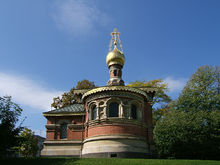Russian Chapel (Bad Homburg)
As Russian Chapel is Russian Orthodox All Saints - Church in Bad Homburg referred. The church was designed on the initiative of the Russian State Councilor Alexej J. Proworoff by the St. Petersburg architect Leonti Benois (1856–1928), the grandfather of Peter Ustinov , and built from 1896 to 1899 under the direction of building officer Louis Jacobi (1836–1910) built on the Kaiser-Friedrich-Promenade in the southern part of the Bad Homburg spa gardens . Previously there was a graduation tower at this point in the spa park , which is now located in Bad Nauheim .
history
State Councilor Proworoff (called the Rosenkavalier ), who like many of his compatriots, was a frequent guest at the spa even after the Bad Homburg casino was closed, with the support of the head of the Russian embassy church in Berlin, Archpriest Alexej Maltzew and the brotherhood of Prince Vladimir, raised the financial means for the construction the chapel, the city of Homburg provided the building site in the spa gardens.
On October 16, 1896, the foundation stone was laid in the presence of the Russian Tsar couple Nikolaus II and Alexandra Fjodorovna (née Alix von Hessen-Darmstadt) (this point is marked with a cross on the outside of the north side). The inauguration took place - without the Tsar couple - on September 22nd, 1899. In the interior, two brass plates indicate the dates of the presence of the imperial family.
architecture
The building is in the style of the Russian churches of the 16th century. The crossing is surmounted by an onion dome. The facades are decorated with elements of brick clinker construction, a gilded frieze and tiles with a Russian double-headed eagle. The interior of the church was painted in 1985 with frescoes by the Russian church painter Adam W. Russak. The icons, the rosewood iconostasis, are painted on galvanized sheet metal. The fresco above the entrance, an icon of the non-hand-made image of Christ, is by Adam W. Russak . Louis Benois realized a similar church building between 1897 and 1899 with the Russian Chapel in Darmstadt .
Parish
The parish of the All Saints Church initially belonged to the Russian Orthodox Diocese of Saint Petersburg and from 1922 to 1947 to the jurisdiction of the Metropolitan of Paris and Western Europe Evlogij. Since 1947 it has belonged to the Russian Orthodox Church abroad, according to a resolution of the local council . The All Saints Church is owned by the city of Bad Homburg. From 1922 to 1946 there were almost no services in the church. The interior decoration was kept in Bad Homburg Castle and brought back in 1946 with the help of parishioner Heinrich Andreas Peiker and priest Leonid Kaspersky (later archpriest); after that the church was re-established. Kaspersky was followed by the priests Evgeni Siletzki and in 1952 priest Leonid Graf Ignatiew (later also archpriest). Today it is directed by Archpriest Dimitri Graf Ignatiev. The Bad Homburg community belongs to the parish of St. Nicholas in Frankfurt-Hausen. In the church there are regular services in German and Church Slavonic .
Web links
- Website of the Orthodox Church Community Frankfurt am Main e. V.
- 3D tour
- Russian Orthodox Church of All Saints. Bad Homburg , in: Hochtaunuskreis - District Committee (ed.), Church leaders. Kirchen im Hochtaunuskreis , 2006, pp. 20–21.
Footnotes
- ^ Baurat Jakobi later led the reconstruction of the Saalburg Fort (1898–1907).
Coordinates: 50 ° 13 ′ 33 ″ N , 8 ° 37 ′ 31 ″ E



